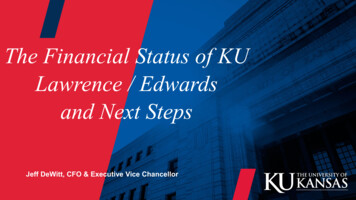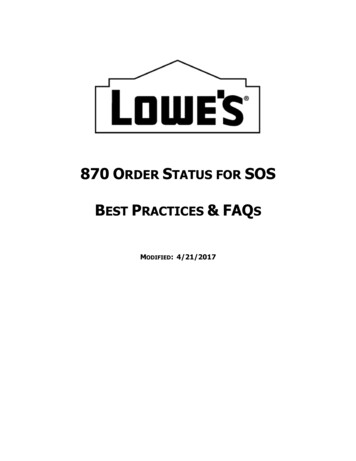
Transcription
The Financial Status of KULawrence / Edwardsand Next StepsJeff DeWitt, CFO & Executive Vice Chancellor
The Financial Status of theKU Lawrence/Edwardsand Next StepsThe Big Picture of KU FinancesThe Combined Financial Picture of KUHow Did We Get Here? Role of Revenue GrowthHow Did We Get Here? Role of Expense GrowthEstablishing the Base to Forecast AheadThe Key Assumptions of the ForecastThe Forecast! What is the Structural Deficit?What Could Make it Better or Worse?Next StepsQ&A
Page 2The Approach to Layout the Financial PictureWhat are you about to see and hear? Discussion of where we get our money and how we spend it The complex financial picture made more difficult since the only public document, theAnnual Financial Report (AFR), shows combined financial information A review of what has happened to key revenue since the "Great Recession" A review of changes in expenses over same time period Setting the base for KU finances and breaking it down from the AFR to see what must befunded by State funding and Tuition Looking out past the budget year so any new problems are addressed before they occur(financial planning) Showing the financial deficit and strategies to address it
Page 3Big Picture - KU Generated Revenues of 1.4 billion in FY 2020Where Does the Money Come From?Where Does the Money Go?
Page 4What Makes Up KU's Combined Financial Report?University of Kansas - Lawrence, Edwards Supported by State funding and Tuition Supported by other revenuesUniversity of Kansas - Affiliates: (501-C3s)1.2.3.4.5.Kansas University Endowment Assocation (KUEA)Kansas AthleticsKU Center for Research (KUCR)Kansas Memorial Union Corporation (Union)KU Campus Development Corp. (Central District)1.2.3.4.Student HousingWatkins Health ServicesKU Recreation ServicesParking & TransitUniversity of Kansas - Auxiliaries:Kansas University Medical CenterRestricted or MostlyRestricted for Use byKUL (Self Supporting)
Page 5Picture of KU's Combined Financial RevenuesFY 2020 Total Consolidated Revenues 1.4 Billion
Page 6Getting to the State Funding and Tuition Supported Part of KUStatement of Revenues, Expenses, and Changes in Net Assetsfor the Year Ended June 30, 2020(Natural Classification)OPERATING REVENUESTuition and feesState appropriationsFederal grants and contractsState and local grants and contractsNongovernmental grants and contractsSales and services of educational departmentsSales and services of medical and administrative activitiesAuxiliary enterprises:HousingAthleticsParkingStudent unionsUniversity health servicesOther auxiliary enterprisesOther operating revenuesLocal appropriationsGiftsInvestment income (loss)Nonoperating Federal grants and contractsOther nonoperating revenuesTotal revenuesOPERATING EXPENSESCompensation & BenefitsScholarships and fellowshipsUtilitiesSupplies & Other ServicesDepreciationInterest expenseOther nonoperating expensesTotal expensesIncome (loss)FINANCIAL STATEMENTKANSASKU 6862,942,861KU 91559,373,45765,195,70962,942,861KU CENTERFOR 616,06030,899,832CAPITAL TRANSACTIONSCapital appropriationsCapital grants and gifts (expense)Transfers (to)from UniversityAdditions to permanent endowmentsTotal capital 48,117801,5474,749,664Total Increase 4,825)KU CAMPUSDEV ,902
Page 7How Did We Get Here? Role of Revenue GrowthWhat is Role of Revenue Growthin Any Structural Deficit
Page 8State General Fund (SGF) Support, 2008 - 2021SGF Support Unadjusted (in millions)SGF Support Adjusted for CPI in FY 2021 dollars (in millions)State Funding has been Declining in Real (inflationadjusted) Dollars since the "Great Recession"
Page 9KU Lawrence / Edwards Student HeadcountStudent Headcount hasremained relatively flat from2012 through 2019Headcount declined 2.9% fromFall 2019 to Fall 2020Non-resident student growth hascompensated for decline inresident students
Page 10KU Lawrence / Edwards Undergraduate TuitionTuition Increased to Offset Lack of State Funding Growth Annual tuition assumes30 credit hours per year Tuition does not includemandatory campus feesor School specificcourse fees
Page 11KU Lawrence / Tuition Revenue Growth and WaiversWaivers: Midwest Student Exchange program expanded to all KU majors in Fall 2016 KU Excellence program introduced in Fall 2018 and expanded out of state waivers
Page 12Undergraduate Tuition & Fees comparison – Big XIIIntroductory sentence goes hereKU tuition and fees second highestamong Big XII publics and fourthhighest overallRecent freezing of tuition Increaseshave made KU more competitive
Page 13How Did We Get Here? Role of ExpensesWhat is Role of Expense Growthin the Structural Deficit ?
Page 14How Did We Get Here? Role of ExpensesPermanent BaseBudget Cut(0.8% - 5.8%)Cash Budget Cut(0.75 – 5.8%)Permanent BaseBudget Cut &State ImposedSpending Limit(1.8%)Operating Expenses do not include depreciation
Deferred Maintenance Building & InfrastructureCampus water linebreakPipe Break atMax Kade Center*Does not include Lawrence Campus Affiliates or Auxiliaries (Athletics, KUCR, KUEA, Unions,Housing, Parking, Rec Services, Watkins).
Page 16Financial Analysis: Setting the Base 6% Fiscal Year 2022Base BudgetReductionsFrom the Annual Financial Report (published byKUand4% Tuition Growthin AcademicYearsaudited by State) you pull out KUL to start (bluesliceon2023 & 2024earlier chart, page 6). No Merit in FiscalYears 2023 & 2024 No Other OperatingFrom that you isolate any expenses that remainExpenseto be(OOE)Increase in FiscalYears 2023 & 2024covered by Tuition and State funding.The details are in the “supplemental information” sectionfollowing the presentation.
Page 17Key Assumptions of Financial Forecast - FY22Auxiliaries and Affiliates carry themselves with exception of Federal HEERF Money for Union, Housing andWatkins to meet expenses while they recoverFOR FY 2022 State Funding is Level Currently Submitted to the Governor by the State LegislatureEnrollment Stays Flat Relative to 2021No Increase in Tuition RatesRecent Debt Service Savings from Refinancing ReflectedDeferred Maintenance Funding Increased by 2.5 million over 2021KUEA Funding Provides Start-up for Strategic Growth InitiativesTakes advantage of better-than-expected revenue and lower expenses in 2021 to carryover 20million ( 20 million is maximum amount before cash levels threaten credit rating) Uses the Federal Higher Education Emergency Relief Funding (HEERF) to support KUL, Union,Housing and Watkins all impacted significantly by Covid-19 ( 24 million) Reduces spending as necessary to carry through to FY 2023 where no "one time" funding is available.
Page 18Key Assumptions of Financial Forecast, FY23 - FY24AssumptionFY23FY24FlatFlat4% increase in growth&/or rate4% increase in growth&/or rateEmployee Pay Raises2.0% increase2.0% increaseOperating Costs2.5% increase2.5% increaseStrategic Growth Investments 2,500,000 5,000,000Deferred Maintenance Investment 5,000,000 10,000,000None neededNone neededState General FundingTuition GrowthAuxiliary & Affiliate Financial Support Assumes Deficits in FY 2024 Addressed by Future Efficiencies, GrowthInitiatives, or Future Budget Reductions, or Combination of the Three
Page 19The Forecast: What is the Structural Deficit? 6% (VSIP)Fiscal Year 2022No cuts beyond the FY 2021 Voluntary Separation Incentive ProgramFY 2020ACTUALSSources:General Use - State AppropriationsGeneral Use - Lawrence and Edwards TuitionGeneral Use - MiscellaneousTotal Sources:Uses:SalariesFringe BenefitsOperating ExpendituresDebt ServiceDeferred MaintenanceStrategic InvestmentsTotal Uses:Surplus (Shortfall)Address with CarryforwardAddress with one-time Federal COVID moniesFunding for COVID impact for Union, Housing, WatkinsAddress Shortfall with VSIP onlyCarry ForwardFY 2021ACTUALSEstimatedBase BudgetFY 2023ReductionsFY 2022BudgetForecastFY 2024Forecast 4% Tuition Growth 135,531,729 252,932,000 17,612,497 406,076,226 134,657,428 282,504,917 18,291,246 435,453,592 137,219,212 260,432,000 19,343,903 416,995,115 253,127,273 66,119,758 86,890,578 22,782,896 0 241,995,333 62,998,896 80,831,050 23,059,904 0 428,920,505 408,885,184 259,041,625 69,403,995 96,135,574 21,468,641 2,500,000 0 448,549,835 6,533,087 8,109,931( 42,473,609) 20,000,000 22,245,580( 4,700,000) 5,473,972 545,943in AcademicYears 135,531,7292023& 2024 263,049,280 17,880,063No 416,461,072Merit in FiscalYears 2023 & 2024 135,531,729 273,571,251 18,111,692 427,214,672No 261,004,063Other Operating 267,124,123Expense(OOE) 70,253,653 72,701,922 99,456,963Increasein Fiscal 102,793,387Years 20,805,4082023 & 2024 20,860,175 5,000,000 2,500,000 459,020,087 10,000,000 5,000,000 478,479,607( 42,559,015)( 51,264,935) 545,943( 42,013,072)( 42,013,072)( 93,278,007)
Page 20The Forecast: What is the Structural Deficit?Apply additional cuts to balance through FY 2023FY 2020ACTUALSSources:General Use - State AppropriationsGeneral Use - Lawrence and Edwards TuitionGeneral Use - MiscellaneousTotal Sources:Uses:SalariesFringe BenefitsOperating ExpendituresDebt ServiceDeferred MaintenanceStrategic InvestmentsTotal Uses:FY 2021ACTUALSEstimated 6% Fiscal Year 2022Base BudgetFY 2023ReductionsFY 2022BudgetFY 2024ForecastForecast 4% Tuition Growth 135,531,729 252,932,000 17,612,497 406,076,226 134,657,428 282,504,917 18,291,246 435,453,592 137,219,212 260,432,000 19,343,903 416,995,115 253,127,273 66,119,758 86,890,578 22,782,896 0 241,995,333 62,998,896 80,831,050 23,059,904 0 428,920,505 408,885,184 259,041,625 69,403,995 96,135,574 21,468,641 2,500,000 0 448,549,835 6,533,087 8,109,931in AcademicYears 135,531,729 135,531,7292023& 2024 263,049,280 273,571,251 17,880,063 18,111,692No 416,461,072Merit in Fiscal 427,214,672Years 2023 & 2024No 245,756,383Other Operating 251,571,493 66,113,162 68,422,559Expense(OOE) 96,867,050Increasein Fiscal 100,138,726 20,805,408Years2023 & 2024 20,860,175 5,000,000 2,500,000 437,042,003 10,000,000 5,000,000 455,992,953( 42,473,609)( 20,580,931)( 28,778,281)Address with CarryforwardAddress with one-time Federal COVID moniesFunding for COVID impact for Union, Housing, WatkinsAddress Shortfall Permanent Reductions 20,000,000 22,245,580( 4,700,000) 26,921,302 21,993,273Carry Forward 21,993,273Surplus (Shortfall) 1,412,342 1,412,342( 27,365,939)
Page 21The Forecast: What is the Structural Deficit?– The Do Nothing ScenarioBalanced solely due toone-time fundingThe Do NothingScenario Only reductions are 5.5 million forpermanent VSIP 4% Tuition Revenue Growth inAcademic Years 2023 & 2024 2% Merit in Fiscal Years 2023 &2024 2.5% Increase in Other OperatingExpense (OOE) Fiscal Years 2023 &2024 Funding for strategic growthinitiatives and minimal increasedfunding for deferred maintenance
Page 22The Forecast: What is the Structural Deficit?– Expense ReductionsThis solution results in smallest responsible budget reductions in FY2022 and provides time to find additional solutions before FY 2024Expense Reductions in FY 2022 toBalance 2023 where no "One-time"funding is available Future ActionsRequired to Balance FY 2024(RECOMMEDATION) Reduce Expenses 26.9 millionin 2022 (includes VSIP) 4% Tuition Revenue Growth inAcademic Years 2023 & 2024 2% Merit in Fiscal Years 2023 &2024 2.5% Increase in Other OperatingExpense (OOE) in Fiscal Years2023 & 2024 Funding for strategic growthinitiatives and minimal increasedfunding for deferred maintenance
Page 23What Could Make it Better or Worse?What Could Make it Better? 6% Fiscal Year 2022Base BudgetReductions State Begins to Increase Annual Funding 4% Tuition Growth State Shares Federal Covid Funding that Can be Used to Buy MoreTime toYearsin Academic2023 & 2024Implement Efficiencies and Growth Initiatives Better than Expected Growth in Revenues that Offset the Need forandNoTuitionMerit in FiscalState FundingYears 2023 & 2024 Expenses are Below Budgeted Levels Providing Carryover Funds in Future Years No Other OperatingWhat Could Make It Worse? Expense (OOE)Increase in FiscalYears 2023 & 2024State Funding Declines Similar to Recent YearsEnrollment Drops Rather than Staying Flat or GrowingUnplanned Expenses Occur or Expenses not Effectively ManagedInflation Begins to Increase Beyond Forecast LevelImplementation of KBOR Deferred Maintenance Policy
Page 24WHERE DO WE GO FROM HERE? NEXT STEPSNEXT STEPS: Lawrence/Edwards Collectively Adjust Budgets to Reduce Expenses by 26.9 million for FY 2022 Support Jayhawk Rising Strategic Plan by Developing a Five-year Financial Plan and EnsuringStrategies to Address Structural Deficits Begin Collecting Ideas from Everyone On How We Can Be more Efficient and Grow to MinimizeFY 2024 Impact Develop Strategic Growth and Efficiency Plans for Implementation Partner with Auxiliaries and Affiliates on Similar Five-year Plans Develop a Long-range Capital and Financial Plan to Addressed Deferred Maintenace Educate Citizens and Business Community on Impact of the Lack of Growth in State Funding
Page 25FREQUENTLY ASKED QUESTIONS Can KU Endowment or KU Medical Center Resources be Used to Solve the BudgetChallenge? What is the Financial Impact of the KU Central District? Why are KU Cash Reserves and Credit Rating Important? Why has KU not Previously Budgeted over a Longer Period of Time? Why is KU not Implementing Across the Board Budget Reductions? Why did the Fiscal Year 2019 Budget Cut of 20 million not Solve KU's FinancialIssues?
Page 27QuestionsAndAnswers
What Makes Up KU's Combined Financial Report? University of Kansas - Lawrence, Edwards Supported by State funding and Tuition Supported by other revenues University of Kansas - Affiliates: (501-C3s) 1. Kansas University Endowment Assocation (KUEA) 2. Kansas Athletics 3. KU Center for Research (KUCR) 4. Kansas Memorial Union Corporation (Union) 5.











